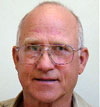
Presentations Abstracts
 |
Deborah
Koff-Chapin; Founder of The Center for Touch Drawing What is the relationship between dreaming and creative expression? When we draw upon the felt sense and wisdom of the body in an expressive art form, can we tap the same source and open to transformative processes as we do in deep dream work? In this presentation, Deborah Koff-Chapin will share her own experiences using the process of Touch Drawing to support her through major life transitions, and develop inner vision and intuition. Touch Drawing is a simple yet profound way of creating spontaneous images through the touch of fingertips on paper. Deborah will present basic instructions for Touch Drawing, to be done either during or after this conference. She will share how people are using this process for deep soul work in a range of settings. In the conference forum, she will invite participants to explore how they might incorporate Touch Drawing and other expressive arts forms into their personal and professional dream work practice. Deborah will invite interested participants to continue the exploration begun during this conference in a special interest group in the free online Touch Drawing Community. |
|
 |
Jon Lipsky Dreaming Together is a way to re-experience your dreams by acting them out. I will present two or three dreams from my book “Dreaming Together” which you can act out, but you are welcome to participate using one of your own dreams. In our discussions, you will be asked to share the experience of acting out different images from either the dreams I present, or the dream you choose to present. However, it is essential in this work that, in acting out the dream you play all the parts. By playing all the parts, you will embody all the aspects of the dream and view each important moment from inside the image. This entails narrating the dream with body and voice. One could do this sitting in a chair, but it is better to do it standing up. One could also do this alone in one’s room, but it is better to do it with a partner, so you have someone to communicate with (and someone who can ask you questions about the details of your dream). Whether you choose to participate alone sitting in a chair, or up on your feet with a partner, the important thing is that you play all the parts, taking on physically and vocally the feeling tone of each image, describing it in detail using body and voice. You don’t have to be an actor to do this. Just tell the dream the way you would tell a fairy tale to a bunch of kids, playing all the parts, and using body and voice to describe not only the characters but the settings and the actions. This will help you avoid an over emphasis of the “I” narrator and expand your idea of what is important in the dream. New thoughts and feelings are likely to accompany this total immersion in every aspect of the narrative. In our discussions, of course, there is no correct or incorrect notion of the dream images. But we should have a lively interchange about the effect of playing all the parts and embodying images with body and voice, how these techniques help you experience someone else’s dream, or re-experience your own dream. |
|
 |
Paco Mitchell World Dreams Occasionally a dream comes along which transcends the personal psychology, circumstances and concerns of the individual dreamer. Naturally, there are many variations on this type of dream, and we could give them any number of names – cosmic, transcendent, transpersonal and so on. In this presentation, I would like to focus on what I call “World Dreams.” A world dream comments on what is happening to the world, in a broad sense. It often points to processes that are under way, and can provide hints as to our prospects for the future. A world dream affects all of us, with all our worldly concerns. But it can just as easily refer to monumental, archetypal shifts in spiritual or cultural perspectives and world-views, as it can refer to the daily travails of individuals. But let’s not try to define such dreams too finely or narrowly, since it is in the nature of dreams to surprise us. By discussing a few of my own world dreams, I will try to demonstrate at least some of the potentials and qualities of this under-represented category. Hopefully, other dreamers may recognize world dreams of their own, and be moved to offer them to whatever audience lies within their reach. I have no doubt that dreams in general, and world dreams in particular, are generators and transformers of visionary energy, and that they are informing our future as we speak.
|
|
| back to presenter's page | ||
|
|